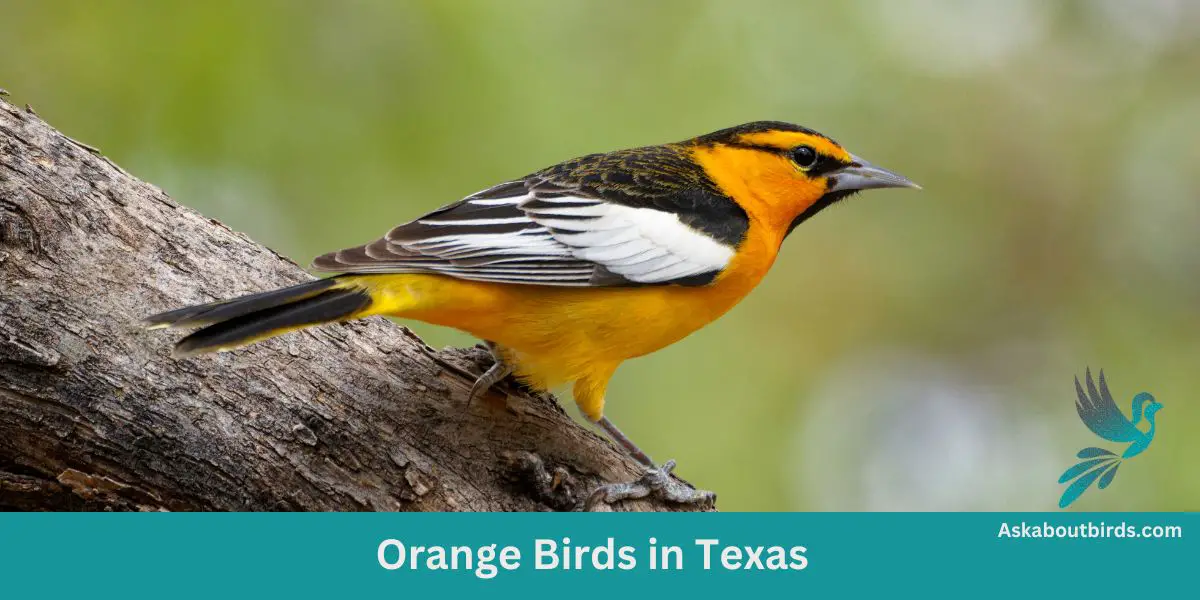Deep in the heart of Texas, the sky is painted with a spectrum of avian colors, but the fiery hues of orange birds stand out brilliantly against the vast landscapes. From the brush country of South Texas to the Piney Woods in the east, these vibrant flyers captivate birdwatchers and nature enthusiasts alike.
Orange Birds Found In Texas
The state acts as a significant crossroads for migratory routes, especially for birds making their journey between North and Central America. Its multitude of ecosystems, influenced by the Rio Grande, extensive coastline, and vast grasslands, provides different habitats that support a wide range of species.
Baltimore Oriole


| Feature | Measurement |
|---|---|
| Scientific Name | Icterus galbula |
| Length | 6.7–8.7 in |
| Wingspan | 9.1–12.6 in |
| Weight | 22.3-42 g |
The Baltimore Oriole is a stunning bird, best known for its vibrant coloration and its rich, whistling song.
Appearance: The male Baltimore Oriole is notable for his bright orange and black plumage and black and white wing bars, a stark contrast to the more muted yellow-brown coloration of the female. Both sexes, however, have long pointed bills and white bars on their wings.
Diet: Baltimore Orioles have a diverse diet that includes insects, fruits, and nectar. Their preference for sweet juices and fruit pulp often brings them to backyard feeders offering oranges and jelly.
Reproduction: The female Baltimore Oriole is responsible for building the distinctive hanging nest, often woven together from fine materials like hair and grass. These nests are usually high in trees to avoid predators. The female lays 3-7 eggs, which are incubated for about two weeks.
Orchard Oriole
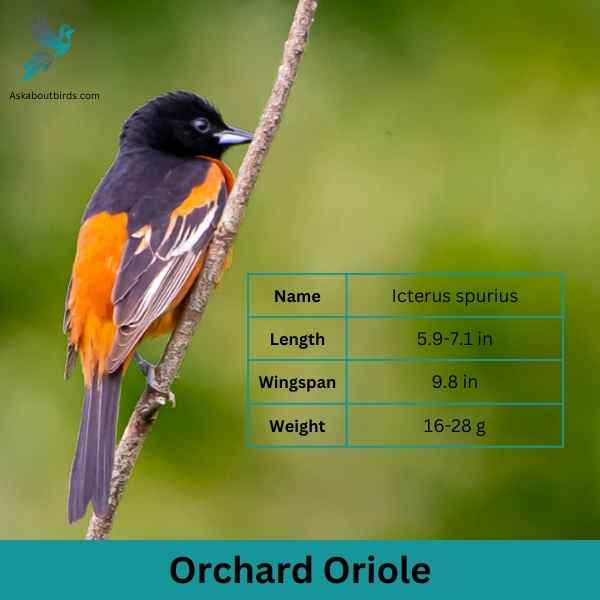
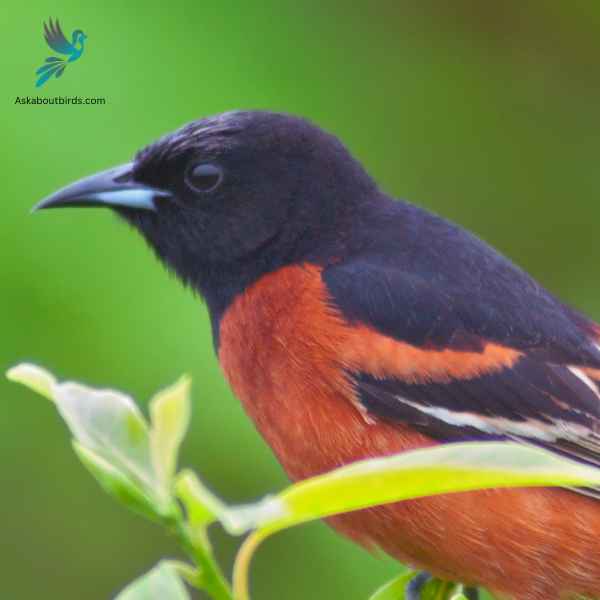
| Feature | Measurement |
|---|---|
| Scientific Name | Icterus spurius |
| Length | 5.9-7.1 in |
| Wingspan | 9.8 in |
| Weight | 16-28 g |
The Orchard Oriole is a small songbird noted for its distinctive coloration and melodic song.
Appearance: Male Orchard Orioles are a striking sight with their dark chestnut body and black head and black and white wings, while females and immature males are olive-green and feature a yellowish underpart. The species is often recognized by its slender body and pointed bill.
Diet: The diet of the Orchard Oriole consists primarily of insects, fruits, and nectar. They are adept at catching insects mid-air and are also known to sip nectar from flowers, aiding in pollination. When fruits are in season, they make up a substantial portion of the bird’s diet.
Reproduction: Orchard Orioles often nest in open woodlands and orchards, hence their name. The female is responsible for building the nest, typically choosing a location in a tree or shrub. The female lays a clutch of 4 to 6 eggs, which she incubates for about two weeks.
Red-breasted Nuthatch

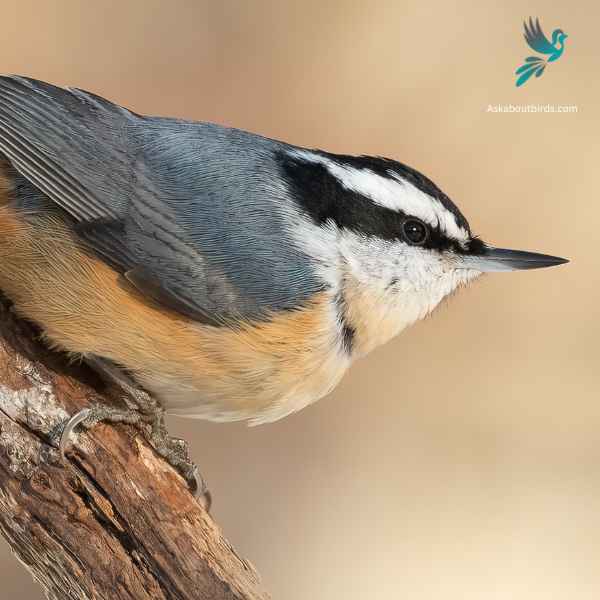
| Feature | Measurement |
|---|---|
| Scientific Name | Sitta canadensis |
| Length | 4.3–4.7 in |
| Wingspan | 8.3 in |
| Weight | 0.3–0.5 oz |
The Red-breasted Nuthatch is a small, agile songbird, known for its ability to move headfirst down tree trunks while searching for food.
Appearance: This bird boasts a slate-blue back and a pale rust-red underside. A prominent black stripe runs through the eye and is bordered above by a white eyebrow. Their sharp, pointed bill is characteristic of the species.
Diet: Red-breasted Nuthatches primarily feed on insects and seeds, especially those from coniferous trees. They have a fondness for large seeds, which they wedge into bark crevices to hack open with their bills.
Reproduction: These birds construct nests in natural tree cavities or abandoned woodpecker holes, often lining the entrance with resin. This is thought to deter predators or competitors from entering. The female typically lays a clutch of 5 to 6 eggs, and both parents partake in feeding the chicks once they hatch.
Bullock’s Oriole

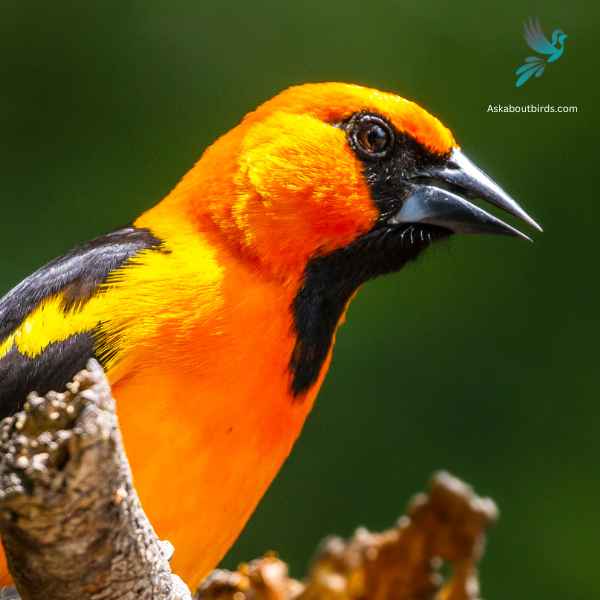
| Feature | Measurement (Imperial) |
|---|---|
| Scientific Name | Icterus bullockii |
| Length | 7.5-8.5 inches |
| Wingspan | 11.8-12.6 inches |
| Weight | 0.9-1.2 oz |
The Bullock’s Oriole is a bright and lively songbird, known for its stunning contrasting colors and vibrant melodies, predominantly found across the western regions of North America.
Appearance: The male Bullock’s Oriole boasts a brilliant orange chest, belly, and face with a black crown, eye line, throat, and back. Its wings are black with a prominent white patch and white-edged coverts. Females are more muted in coloration, displaying a yellowish-orange hue with grayish-brown wings that still retain the white patches.
Diet: These orioles primarily feed on insects, especially caterpillars, beetles, and grasshoppers. Apart from insects, their diet also includes fruits, berries, and nectar. They’re adept foragers, often hanging upside-down on branches to find hidden prey.
Reproduction: Bullock’s Orioles are noted for their skill in crafting hanging, woven nests, often positioned on the tips of slender branches, ensuring they are difficult for predators to access. Both parents partake in feeding the young, who then fledge about two weeks after hatching.
Barn Swallow

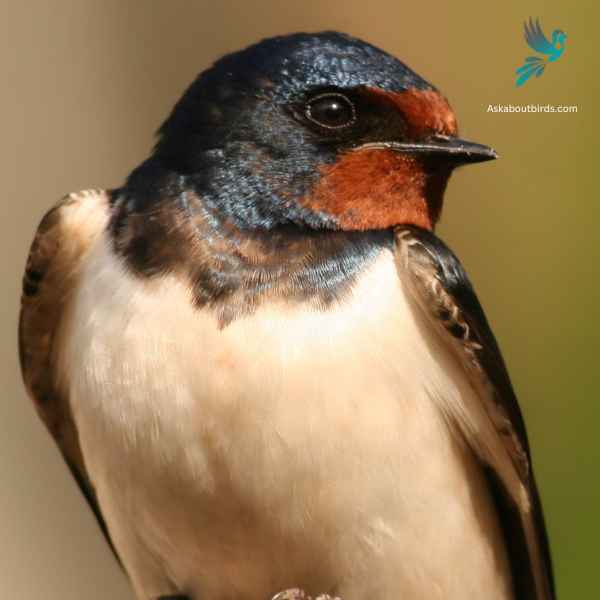
| Feature | Measurement |
|---|---|
| Scientific Name | Hirundo rustica |
| Length | 6.5–7.5 in |
| Wingspan | 12.5–13.5 in |
| Weight | 16–22 g |
The Barn Swallow is a sleek, agile bird renowned for its graceful flight patterns and iconic forked tail, often seen darting over fields and water bodies in search of flying insects.
Appearance: Barn Swallows have deep blue, almost iridescent, upperparts and a rufous to tawny underbelly. Their distinctively forked tail and long wings give them a streamlined look. Both males and females have a similar appearance, though males often exhibit slightly brighter colors and a deeper fork in the tail.
Diet: Barn Swallows feed primarily on flying insects, which they catch in mid-air during their agile and acrobatic flights. Their diet includes flies, beetles, moths, and other small flying insects.
Reproduction: Barn Swallows are known for building their mud nests on man-made structures, particularly barns, bridges, and eaves. The nest is cup-shaped and made from mud pellets, often lined with feathers. The female lays a clutch of 4 to 6 eggs.
American Robins


| Feature | Measurement |
|---|---|
| Scientific Name | Leptotila plumbeicep |
| Length | 10.6-11.8 in |
| Wingspan | — |
| Weight | 160-200 g |
The American Robin is a widely recognized bird species known for its melodious song and early bird tendencies.
Appearance: American Robins are medium-sized birds with a distinctive appearance. Both males and females sport a gray to brown back and a warm red to orange breast and belly and gray wings. They also have a characteristic white eye-ring and a black head, but males are usually darker than females.
Diet: American Robins have a diverse diet that changes depending on the season. In summer, they feed heavily on earthworms, beetles, and other invertebrates, which they catch on the ground. During winter, they mostly eat fruits and berries.
Reproduction: American Robins usually build their nests in trees or shrubs, but they are also known to nest on human-made structures. The female lays a clutch of about 3 to 5 eggs, which she incubates for about 12 to 14 days.
Eastern Towhee

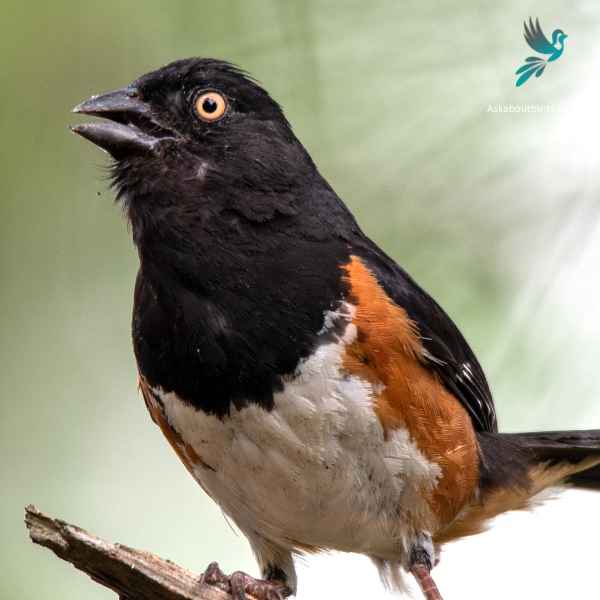
| Feature | Measurement |
|---|---|
| Scientific Name | Pipilo erythrophthalmus |
| Length | 6.8 to 9.1 in |
| Wingspan | 7.9–11.8 in |
| Weight | 32 to 53 g |
The Eastern Towhee is a distinctive songbird known for its unique calls and eye-catching coloration.
Appearance: Male Eastern Towhees are characterized by a striking combination of a black head, back and tail, contrasting with a white belly and rufous flanks. Females sport similar patterns but instead of black, they have a rich brown color. Both genders have red eyes, lending a special charm to their overall appearance.
Diet: Eastern Towhees primarily feed on a variety of insects, seeds, and berries. Their diet is quite diverse, taking advantage of seasonal offerings, which includes beetles, caterpillars, spiders, acorns, grass seeds, and various fruits and berries.
Reproduction: Eastern Towhees build their nests on or near the ground, often in a shrub or a small tree. The female lays around 3-5 eggs and takes the primary role in incubating them over about 12-13 days.
Spotted Towhee

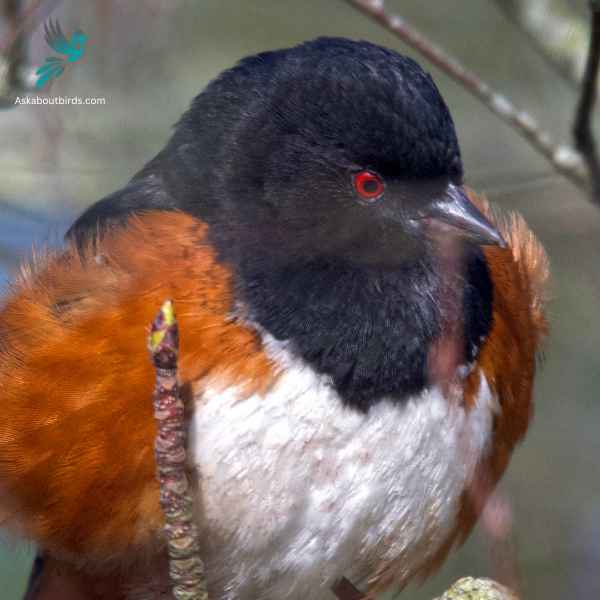
| Feature | Measurement |
|---|---|
| Scientific Name | Pipilo maculatus |
| Length | 6.7-8.3 in |
| Wingspan | 11.0 in |
| Weight | 33 g |
The Spotted Towhee is a distinctive songbird commonly found in the shrubby undergrowth and thickets of the western parts of North America. Its song, a series of melodious chirps, often punctuates the early morning air.
Appearance: Male Spotted Towhees showcase a coal-black head, throat, and upper body contrasted with rufous sides and a white belly. Their wings and back are dark but adorned with white spots, hence their name. Females have a similar pattern but are more brownish than black.
Diet: Spotted Towhees primarily feed on a mixture of insects and seeds. They often forage on the ground, scratching through leaf litter to uncover beetles, ants, and other insects, as well as various seeds and berries.
Reproduction: Spotted Towhees usually nest on the ground, concealed by dense vegetation or sometimes in low shrubs. The female builds the nest and lays a clutch of 3 to 5 eggs. She incubates the eggs, while the male stands guard and both parents partake in feeding the fledglings after hatching.
Vermilion Flycatcher
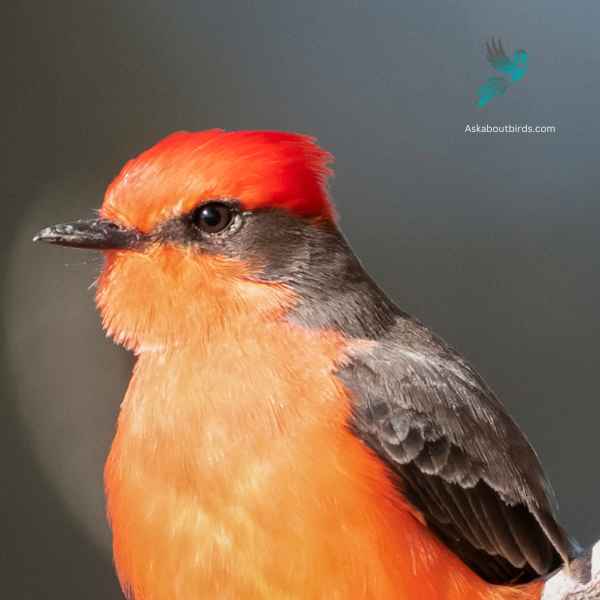

| Feature | Measurement |
|---|---|
| Scientific Name | Pyrocephalus obscurus |
| Length | 5.1–5.5 in |
| Wingspan | 9.4 to 9.8 in |
| Weight | 11 to 14 g |
The Vermilion Flycatcher is a small and colorful bird native to the Americas. The male Vermilion Flycatcher is a striking sight, displaying a vibrant red plumage on its head, breast, and underparts, contrasting with its brown wings and black tail below. Females, on the other hand, have more muted colors, featuring a pale yellowish belly and grayish-brown upperparts.
Vermilion Flycatchers are known for their lively and acrobatic flight displays, which they perform during courtship or to defend their territories. They often sing a series of soft, whistled notes while engaged in these aerial displays. They construct cup-shaped nests, usually in shrubs or low trees, where females lay their eggs and raise their young.
Altamira Oriole


| Feature | Measurement (Imperial) |
|---|---|
| Scientific Name | Icterus gularis |
| Length | 9.1-9.4 inches |
| Wingspan | 9.1-9.4 inches |
| Weight | 2.1-2.4 oz |
The Altamira Oriole is a vibrant and melodious bird known for its contrasting black and orange plumage, predominantly found in northeastern Mexico and the southern tip of Texas.
Appearance: The Altamira Oriole boasts a bright orange body with a black throat, face, wings, and tail. The wings have two white bars and the tail often shows a pointed appearance. Both males and females have similar plumage, though males are generally slightly larger.
Diet: Their diet consists primarily of insects, fruits, and berries. They forage methodically, often probing into foliage or bark crevices to extract insects, spiders, and other arthropods. They are also known to consume nectar from flowers.
Reproduction: Altamira Orioles are known for their intricately woven, pendulous nests which can be over two feet in length. These nests are typically attached to the tips of tree branches, ensuring they are difficult for predators to access.
Blackburnian Warbler
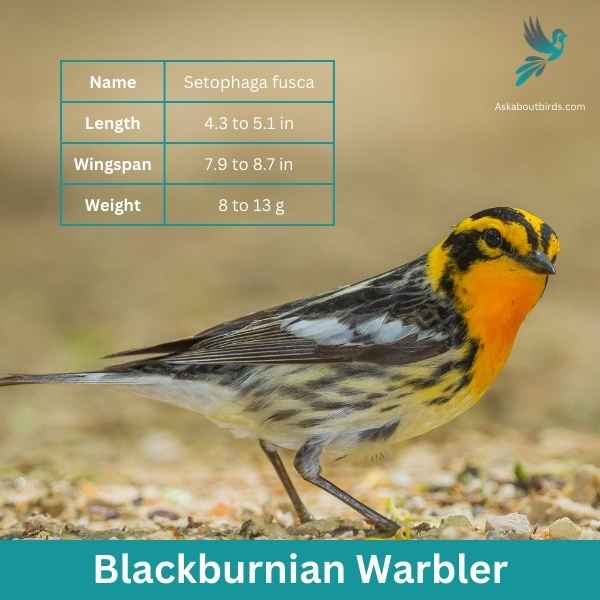

| Feature | Measurement |
|---|---|
| Scientific Name | Setophaga fusca |
| Length | 4.3 to 5.1 in |
| Wingspan | 7.9 to 8.7 in |
| Weight | 8 to 13 g |
The Blackburnian Warbler is a strikingly colored songbird that captivates observers with its vivid plumage, especially during the breeding season. Often found flitting high in the treetops of North American forests, its melodious song is as enchanting as its appearance.
Appearance: Male Blackburnian Warblers are distinguished by their fiery-orange throats, contrasting sharply with a black face, crown, and streaked back. They also have white underparts with black streaks on the sides. Females have a more muted coloration, with a yellowish or pale orange throat and less pronounced streaking.
Diet: Blackburnian Warblers primarily feed on insects and spiders. They are adept at foraging in the canopy, where they glean insects from the surface of leaves and branches or catch them mid-air in quick, agile flights.
Reproduction: Blackburnian Warblers build their nests high up in coniferous trees, often on horizontal branches. The nest is a neat cup made of twigs, grass, and moss, lined with softer materials like hair or feathers. The female lays a clutch of 4 to 5 eggs and takes the lead in incubation.
Black-headed Grosbeak

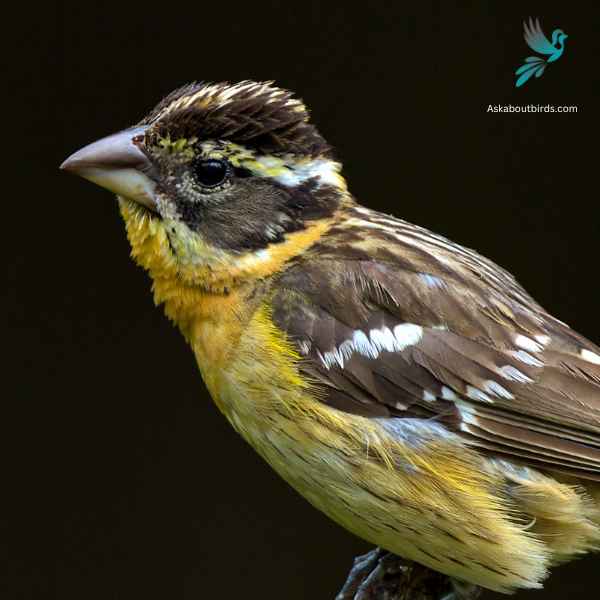
| Feature | Measurement |
|---|---|
| Scientific Name | Pheucticus melanocephalus |
| Length | 7.1–7.5 in |
| Wingspan | 12.6 in |
| Weight | 34–48 g |
The Black-headed Grosbeak is a vibrant songbird known for its melodious song, often confused with that of the American Robin but more rich and varied.
Appearance: Males are recognizable by their orange chest, black head, and black and white wings. Females, on the other hand, have a streaked brown appearance, resembling large sparrows but with hints of orange on their sides and flanks.
Diet: Black-headed Grosbeaks primarily feed on insects, seeds, and fruits. They are especially fond of beetles and caterpillars, and they’re one of the few birds that can eat monarch butterflies without suffering from the toxins.
Reproduction: They often nest in deciduous trees or shrubs. The nest is a loose, cup-like structure made from twigs and grasses. The female usually lays 3 to 4 eggs, which she incubates. Both parents share the responsibility of feeding the chicks.
Hooded Oriole
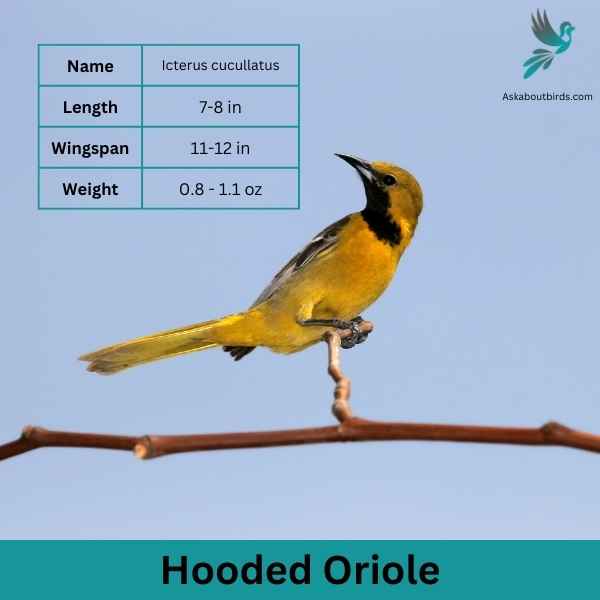

| Feature | Measurement |
|---|---|
| Scientific Name | Icterus cucullatus |
| Length | 7-8 in |
| Wingspan | 11-12 in |
| Weight | 0.8 – 1.1 oz |
The Hooded Oriole is a brightly colored bird commonly found in the southwestern United States and Mexico, recognized for its vibrant orange-yellow plumage and melodic songs.
Appearance: Males boast a deep orange body contrasted with a black bib, face, and throat, while the wings and tail are predominantly black with white wing bars. Females have a paler, yellow-green appearance, lacking the distinctive hood found in males. Both sexes have long tail feathers and a slightly curved bill.
Diet: The Hooded Oriole’s diet mainly consists of insects, nectar, and fruit. They are especially fond of the nectar from flowers and hummingbird feeders, often competing with hummingbirds for access.
Reproduction: These birds are known to use palm trees for nesting, weaving their nests to the underside of large palm fronds. The nest is a deep pouch, which offers protection to the 3-5 eggs that are typically laid. Both parents share in feeding the young after they hatch.
American Redstart


| Feature | Measurement |
|---|---|
| Scientific Name | Setophaga ruticilla |
| Length | 4.3 to 5.5 in |
| Wingspan | 6.3 to 9.1 in |
| Weight | 8.6 g |
The American Redstart is a lively warbler known for its vivid colors and active hunting style, often seen flitting about, fanning its tail to startle and catch insects.
Appearance: Adult male American Redstarts boast striking black plumage with bright orange patches on the sides, wings, and tail. Females and immature males have grayish-olive upperparts with yellow patches in the same areas where the males display orange.
Diet: American Redstarts are primarily insectivores. They actively forage for flying insects, as well as caterpillars and spiders, often using their colorful tails to startle prey and make them easier to catch.
Reproduction: The female American Redstart builds a cup-shaped nest in the fork of a tree branch. Typically, she lays a clutch of 3 to 5 eggs. The female takes on the primary responsibility of incubating the eggs, while both parents participate in feeding the fledglings after they hatch.
Where to Spot Texas’ Orange Birds
Texas, with its vast and varied terrains, offers a rich tapestry of birding locales, where one can find an impressive array of orange-hued birds among many others.
- High Island: Renowned as one of the premier bird-watching spots in the U.S., it’s especially vibrant during the spring migration. The wooded areas attract colorful songbirds, including many with orange plumage.
- Laguna Atascosa National Wildlife Refuge: Located near the southern tip of Texas, this refuge provides a habitat for a mix of coastal and desert birds. Its diverse habitats make it a hotspot for spotting orange birds like the Altamira Oriole.
- Big Bend National Park: Situated along the Rio Grande in West Texas, Big Bend is home to over 450 species of birds. The varied elevations and desert canyons are especially appealing to birds like the Rufous-crowned Sparrow and Scott’s Oriole.
- Aransas National Wildlife Refuge: Famous for the endangered Whooping Crane, this coastal refuge on the Gulf of Mexico also attracts a plethora of songbirds, including several orange-colored species during migration seasons.
- South Padre Island: A renowned migratory bird stopover, especially during spring. The island’s birding centers are a haven for birdwatchers hoping to catch a glimpse of vibrant birds like the Baltimore Oriole amidst a backdrop of coastal beauty.
| State’s Orange Birds | Best Spots for Orange Birds |
|---|---|
| Oklahoma’s Orange birds | 1. Wichita Mountains Wildlife Refuge 2. Red Slough Wildlife Management Area 3. Salt Plains National Wildlife Refuge |
| Arkansas’s Orange birds | 1. Hot Springs National Park 2. Holla Bend National Wildlife Refuge 3. Buffalo National River |
| Louisiana’s Orange birds | 1. Sabine National Wildlife Refuge 2. Atchafalaya National Wildlife Refuge 3. Kisatchie National Forest |
| New Mexico’s Orange birds | 1. Bosque del Apache National Wildlife Refuge 2. Gila National Forest 3. Carlsbad Caverns National Park |
FAQs on Orange Bird Species Found in Texas
What kind of bird has an orange chest in Texas?
In Texas, the Baltimore Oriole is a notable bird with a vibrant orange chest. Males are particularly striking, displaying a bright orange underside contrasted by a black head, back, and wings.
What bird is bright orange in North Texas?
In North Texas, the Summer Tanager stands out for its bright orange-red coloration. Male Summer Tanagers are entirely reddish-orange, making them a unique sight in the region’s forests and woodlands. Another bird to consider is the Vermilion Flycatcher, especially the males, which exhibit a brilliant bright red-orange plumage on their undersides. This bird, though more common in the southwestern parts of the U.S., can also be spotted in parts of Texas.
In the vast landscapes of Texas, from its sprawling plains to forest edges, a vibrant tapestry of avian life thrives. The state’s birdwatchers are often treated to the sight of yellow birds, like the delicate Yellow Warblers, which stand out with their bright yellow plumage against the Texan skies.
The Hooded Orioles, with their bright orange plumage and contrasting black wings, are another captivating sight, especially when they flit about in the sunlight. To attract these feathered wonders closer to their homes, many Texans set up bird feeders stocked with black oil sunflower seeds, a favorite among a multitude of bird species.
These feeders don’t just draw in the brightly colored birds; even red birds and those with subdued hues visit regularly, adding diversity to the backyard spectacle. Moreover, planting berry plants has become a growing trend among homeowners, serving a dual purpose of beautifying gardens and providing natural food sources for avian visitors. With such efforts, Texas ensures a thriving and diverse bird population, making it a paradise for both birds and those who admire them.

